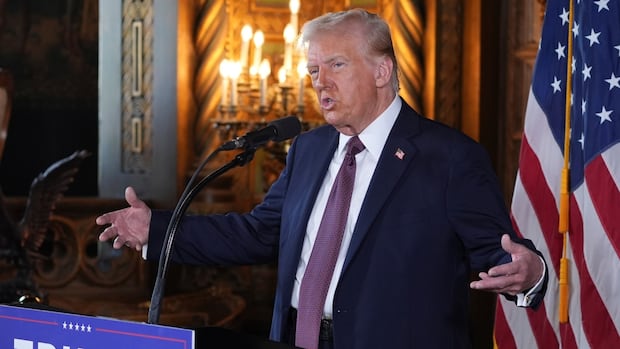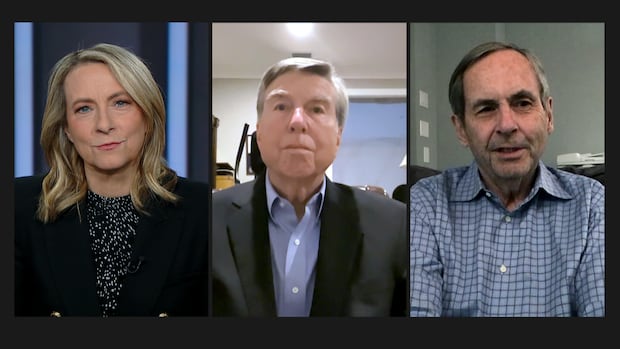Donald Trump’s increasingly strident approach to relations with Canada is provoking fear about the potential consequences north of the border and questions about just how serious the U.S. president-elect actually is.
While already threatening to cripple Canada’s economy by imposing tariffs on the day he returns to the White House, Trump ramped things up on Tuesday by telling a news conference he’s looking to use “economic force” to “get rid” of the border between the two countries.
Trying to translate what Trump says into what he really means can be a fraught exercise.
But with four years of evidence from his first term of turning some of his words into actions, coupled with some hard economic facts about Canada-U.S. trade, it’s possible to draw a few educated conclusions.
“It’s very hard to know when he’s serious about anything, but he does follow through with a lot of his most outrageous statements,” said Matthew Lebo, a political science professor at Western University in London, Ont., in an interview with CBC News.
It also helps to keep in mind the advice of a writer who covered Trump extensively in 2016: to take what he says seriously, but not always literally.
President-elect Donald Trump again outlined his issues with Canada on Tuesday, citing concerns about Canada’s military and asserting that the U.S. is subsidizing the Canadian economy. He ruled out using military force on Canada, saying he would rely on ‘economic force’ when he returns to the Oval Office.
Here’s a guide to trying to understand what Trump means when he talks about Canada.
‘Very serious tariffs’
After initially framing his threat of 25 per cent tariffs on imported goods as something neighbouring countries could avoid if they improve border security, Trump is no longer speaking in conditional terms.
“We’re going to put very serious tariffs on Mexico and Canada,” Trump said during Tuesday’s news conference. It seems the $1.2-billion border security plan the Trudeau government threw together and presented to the Trump transition team last month hasn’t satisfied the president-elect.
Canadian officials are increasingly concerned Trump has already made up his mind to slap tariffs on at least some Canadian exports to the U.S., so officials have drawn up a list of hundreds of American-made goods that Canada is considering hitting with retaliatory tariffs, a senior Canadian government source told the CBC’s Katie Simpson.
There is some skepticism Trump would put tariffs on Canada’s biggest export product — crude oil — as that would likely drive up the price of gas at the pumps in the U.S. But there are plenty of signs he sees no downside to hitting other Canadian goods with such a levy.
His linking of the tariffs to border security provides the ostensible legal justification he needs to impose them. Only Congress has the authority to levy tariffs, with a few exceptions — including if the president declares a national economic emergency, something he threatened to do in relation to Mexico in 2019.
Trump and his pick for commerce secretary, Howard Lutnick, see tariffs as a potentially significant source of revenue for the U.S. Treasury — something that could help fund an income tax cut, despite evidence the move would economically hurt more Americans than it would help.

‘Economic force’
During the news conference, Trump pointedly refused to rule out using the military to take control of the Panama Canal and Greenland. A reporter then asked Trump whether he is “considering military force to annex and acquire Canada.”
“No,” replied Trump. “Economic force.”
Tariffs of 25 per cent would certainly qualify as hefty economic force.
The stark reality is Canada-U.S. trade matters proportionately far more to the Canadian economy than to the U.S. economy. The U.S. accounted for 77 per cent of the value of Canada’s exports and 63 per cent of its imports in 2023. By contrast, Canada accounted for 17 per cent of the value of U.S. exports and just 13.5 per cent of its imports in the same year.
Some Trump-watchers see the tariff threats as a method of gaining leverage in the upcoming renegotiation of the tripartite trade deal that he signed with Canada and Mexico in 2018.
There’s a train of thought that Trump sees Canada as politically weak, given Justin Trudeau’s imminent departure as prime minister and the Liberal Party’s struggles in the polls.
U.S. president-elect Donald Trump is threatening to use ‘economic force’ to annex Canada, but is he serious or is this just another negotiating tactic? The National’s Adrienne Arsenault puts the question to two former ambassadors.
‘Hundreds of billions a year to take care of Canada’
Canadian officials have told CBC News that Trump is frustrated by the U.S. trade deficit with Canada.
He has consistently — and inaccurately — portrayed the trade imbalance as the U.S. subsidizing Canada. He has also exaggerated the size of the trade deficit, which was $68 billion US in 2023.
“We’re spending hundreds of billions a year to take care of Canada,” Trump said at his news conference. “Why should we have a $200-billion deficit? Add on to that many, many other things that we give [Canada] in terms of subsidy.”
Trump gave one example of those “many other things”: defence.
“They rely on our military,” he said. “It’s all fine, but you know, they’ve got to pay for that. It’s very unfair.”
On this, Trump clearly has a point. Canada is currently spending about 1.3 per cent of GDP on defence, well below the NATO guideline of two per cent. Canada would have to spend roughly $21 billion more on the military this year to hit that target. Trump has long griped about NATO countries not pulling their weight in the military alliance.

‘We don’t need anything they have’
In rapid succession during his news conference, Trump said the U.S. does not need to import automobiles, lumber or dairy products from Canada.
While it’s debatable whether that’s true, the mere fact that he’s saying it is sending a chill down the spines of Canadian companies in those sectors.
It’s being read as a sign that Trump is willing to flex U.S. economic muscle to protect American industries.
Laura Dawson, executive director of Future Borders Coalition, a bi-national business group, says Canada needs to show Trump and his officials concrete ways that free trade with Canada is good for the U.S.
“Canada needs a strategy that isn’t just asking for what we need,” Dawson said in an interview with CBC News Network’s Aarti Pole.
“We need proactive proposals that say, ‘Here’s what we’re doing on security, here’s what we’re doing on energy, here’s what we’re doing on critical minerals and advanced manufacturing. We’d really love for you to be on board with this, and this is going to be great for North America,'” Dawson said
Finance Minister Dominic LeBlanc, Foreign Affairs Minister Mélanie Joly, Immigration Minister Marc Miller and International Trade Minister Mary Ng all respond to U.S. president-elect Donald Trump’s comments that he would use ‘economic force’ to absorb Canada into the United States.
‘Get rid of that artificially drawn line’
The notion of Canada becoming the 51st state is the one Trump threat Canadians may not want to take literally, although there are reasons to take it seriously.
In the past few weeks on social media, Trump has frequently mocked Trudeau as “governor” of the “state of Canada” and made references to Canada as the 51st state.
Trump also talked of Canada becoming a state during his late-November dinner with Trudeau. After previously dismissing Trump’s comments as a light-hearted joke, Finance Minister Dominic LeBlanc changed his tune on Wednesday, saying “the joke is over.”
Trump’s amped-up words at his news conference got many other Canadians wondering whether they can really just laugh it off.
“Canada and the United States, that would really be something,” Trump said. “You get rid of that artificially drawn line, and you take a look at what that looks like, and it would also be much better for national security.”
From goofy AI-generated social media posts to threats of ‘economic force,’ Donald Trump has been taking jabs at Canada’s sovereignty for weeks. CBC’s Ellen Mauro breaks down the president-elect’s escalating rhetoric against Canada.
Canada becoming the 51st state is simply not going to happen, says Jim Hines, a nine-term Democrat representative from Connecticut.
He told MSNBC that Trump’s musings on the topic are “little bits of tinfoil and fireworks designed to distract us from the fact that the president-elect is going to completely fail to deliver on the economic promises that he offered people.”
You also have to wonder why Trump or Republicans in Congress would be keen to admit on an equal footing — as required by the U.S. Constitution — a new state with the population of California and the potential to tilt the results of future presidential and congressional elections.
Given that no Canadian political party is advocating becoming the 51st state, and that there’s no evidence of a groundswell of ordinary Canadians pushing to join the U.S., it’s awfully hard to conceive of a scenario in which Canada willingly gives up its status as a sovereign nation.
That is, unless it’s a doomsday scenario: namely, that Trump uses so much “economic force” for a sustained period of time that it brings about a collapse of the Canadian economy, triggering widespread job losses and social unrest north of the border, such that Canadians begin to see joining the U.S. as the only alternative.





